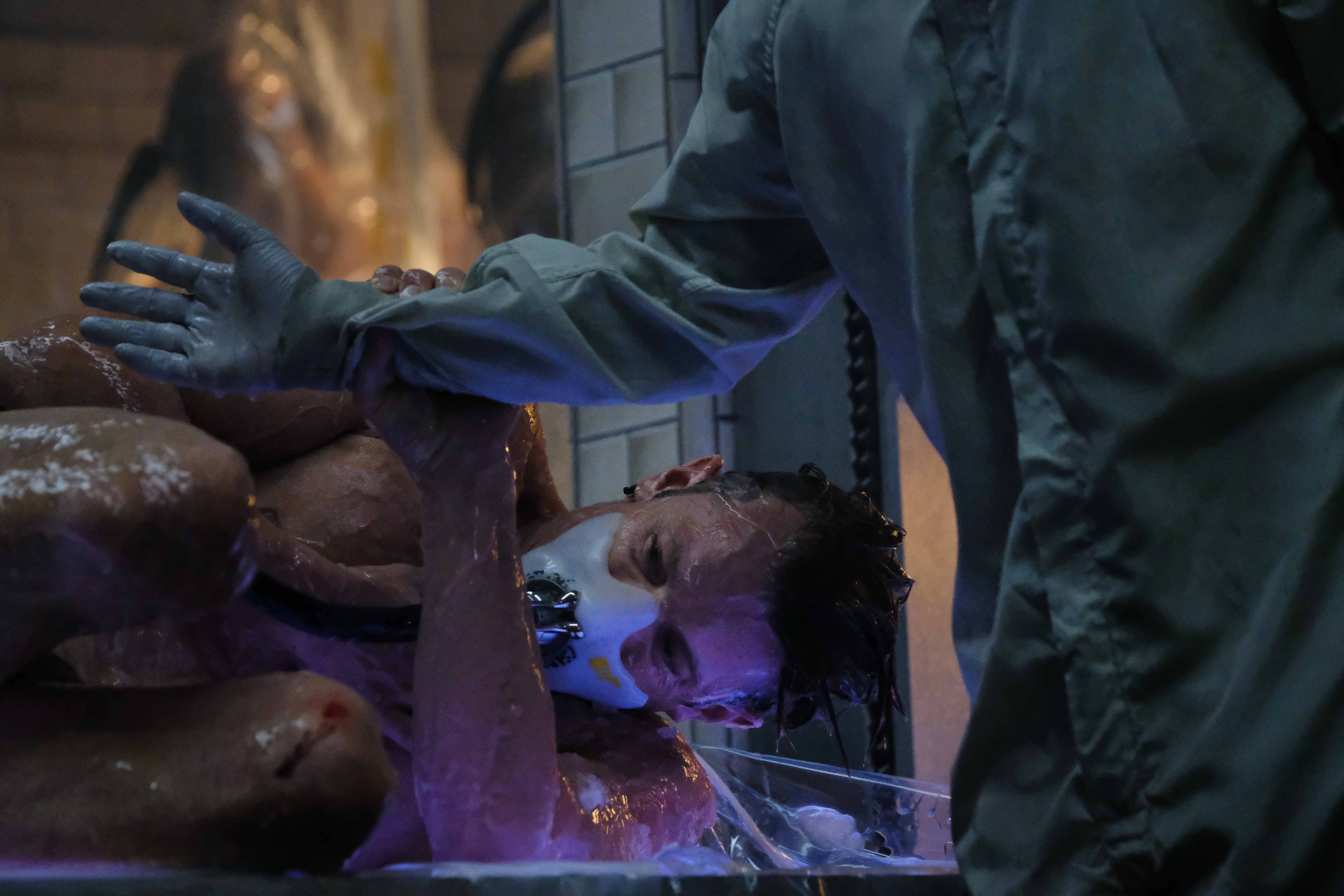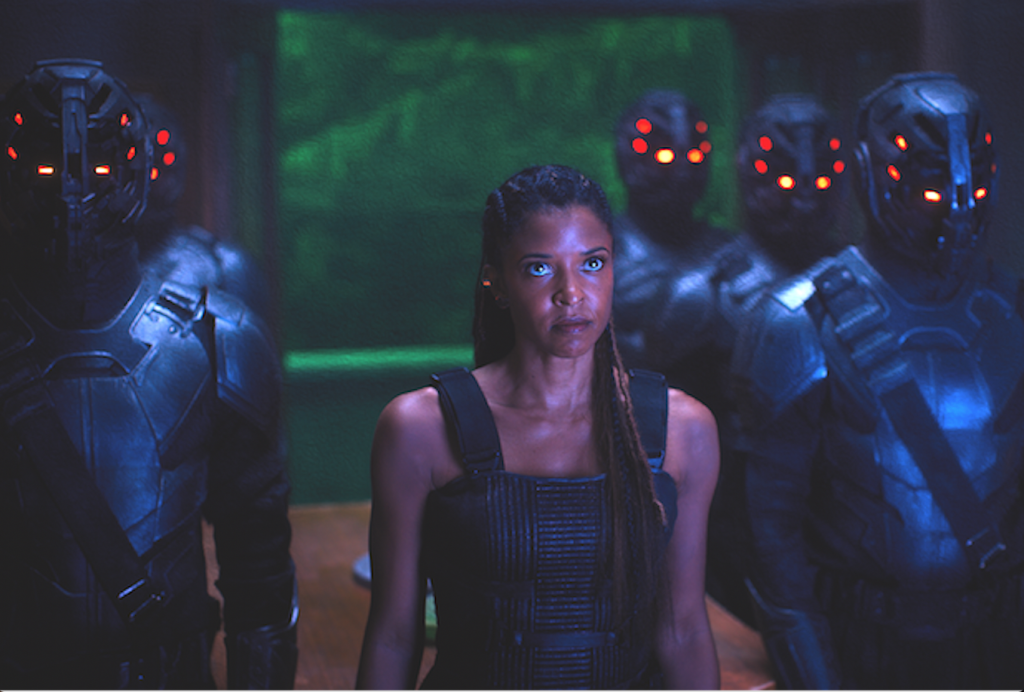
Jahkotta Lewis is a professional archaeologist specializing in Pacific Island…
On February 2, Netflix is plunging into the realm of hardcore science fiction with its original series, Altered Carbon. Carbon is glossy and meticulous, featuring high-end production values that give it a big budget film quality. The series borrows heavily from well-defined science fiction universes and features futuristic Virtual Reality (VR), cloning, neurological tech that’s reminiscent of Strange Days, and takes place in a future where humans wear many faces and have seeded themselves throughout the galaxy.

The aesthetic is reminiscent of Blade Runner, from the constant rain that clouds the cityscapes, to flying police vehicles, to the collared coat rocked by the series protagonist, Takeshi Kovacs (portrayed by Joel Kinnaman); Altered Carbon’s visuals look like they came straight out of Ridley Scott’s 1982 classic.
Altered Carbon is like Demolition Man in some regards, specifically the way it deals with the penal system and social stratification. While Demolition Man stored people cryogenically and re-introduced them to a drastically changed future, Altered Carbon expands on the concept and tells a story of immortality using the idea of cortical stacks. Cortical stacks store the consciousness of individuals within tiny disk looking structures. The stacks are implanted into the spines of humans at birth and serve as backups of the human soul. This way, if a body is murdered or if a person commits a crime, etc., they’re spun up at a later date in VR, or if they are lucky, implanted into a new body or “sleeve.” This technology means that people can live for hundreds of years, if not forever.

Not everyone gets a new body, or sleeve, when their birth body die. In the future, the divide between the wealthy and the poor is stark. The extremely wealthy can afford new bodies when their old one wears out, and navigate the world as immortals. These immortals are referred to as Meths and their influence over society is vice-like. Meths have access to all the wonders and abominations of the universe and take pleasure in the obscene and expensive as a means of satisfying their insatiable boredom.
Takeshi, the main character of the show, is a former super soldier, or Envoy, whose consciousness has been “on ice” for 200 years. Having been stored in an off-world prison for a long list of violent crimes, he suddenly finds himself transported into a new unfamiliar sleeve in the employ of the Meth Laurens Bancroft (James Purefoy). The meat of the series follows Takeshi as he works to be released from Bancroft’s employ by investigating Bancroft’s murder (I can’t explain the obvious weirdness of this scenario without revealing spoilers).
Altered Carbon is based on a book series of the same name written by Richard K. Morgan and is best described as a cyberpunk/neo-noir. The television series was developed by Laeta Kalogridis and stars Joel Kinnaman (Robocop; The Killing), Rene Elise Goldsberry (Hamilton; One Life to Live), Will Yun Lee (Hawaii Five-0), and Dichen Lachman (Dollhouse).

The cast does a great job immersing themselves in Altered Carbon’s world, which stretches from the Metropolis that is Earth all the way to the colonized planets found in the farthest reaches of explored space. The decadence and industrial rot of humanity is tangible in the series, and the narrative draws heavily from the forebearers of science fiction. Altered Carbon seemingly pulls from the philosophical musings of Orson Scott Card, addresses “what is real” like the Wachowski sisters, ponders humanity like Philip K. Dick, and explores concepts of time and what it means to wear different faces as investigated by Octavia E. Butler. This borrowing of ideas from earlier works in science fiction makes Altered Carbon feel familiar, which can be both a good and bad thing. Good, in that sci-fi nerds such as myself can bask in the glow of well-studied sci-fi concepts; and bad in that there aren’t very many new sci-fi concepts introduced in the series. Still, for the most part, Altered Carbon’s narrative is interesting to watch, though at times it can be cumbersome and heavy under its own self-importance.
With that being said, Altered Carbon has several major issues, namely white-washing. Recently, Io9 wrote an article on how the main protagonist of the series is an Asian man in a white man’s body, which is so 2017 Ghost in the Shell. Why Netflix would go ahead with this sort of white-washing after the Ghost in the Shell fiasco is likely due to this narrative being canon to the Carbon books. The show seems to try to compensate for this faux Asian narrative by adding a plethora of diverse characters and ensuring that earlier non-white sleeves of Takeshi are given screen time via flashbacks. While this attempt is admirable (specifically diversifying characters that were otherwise white in the books), it’s not enough. The main protagonist of Altered Carbon should have been portrayed by an Asian American actor.

The frustrating thing about Altered Carbon is that the show features actors that could have easily played the main protagonist (Takeshi). Byron Mann (Street Fighter) and Will Yun Lee both play characters in the show and did phenomenal jobs with their respective roles. No offense to Joel Kinnaman (who does an excellent job as well), but he shouldn’t have played Takeshi. The limited amount of Asian men in leading roles in American television is deafening and this was a wasted opportunity to provide audiences with Asian American representation.
Outside of the whole white dude playing an Asian dude issue with Altered Carbon, there were some other tropes that were present in the series that will certainly be addressed by the Latinx and Asian American community. In regards to Black representation in Carbon, there is a bit of a Magical Negro/sidekick trope present in the series, but is subtle enough that it doesn’t ruin the experience. For the most part, I liked Carbon’s casting choices and character development, especially Renee Goldsberry’s Quell, who is a total badass!

In terms of the narratives of women on the Carbon, there are a variety of power dynamics and levels of agency exhibited by the show’s women. Most of the women of the show were enjoyable to watch, though their connection to Carbon’s themes are largely tied to its male protagonist. Additionally, there was a fair amount of full frontal nudity experienced by Carbon’s leading women while the series’ leading men were regulated to showing their backsides. Hopefully, in future endeavors, Netflix will do away with the Game of Thrones formula of male gaze-y nudity by having Kinnamon show off the family jewels as well. It only seems fair.

All in all, Altered Carbon was entertaining though it definitely has its problems. Hopefully, if it has a second season (which it deserves), the Netflix series will rid itself of any troubling tropes. When it does, it will be perfect.
https://www.youtube.com/watch?v=LFpfeWNzQr4
Altered Carbon streams on Netflix February 2, 2018
What's Your Reaction?
Jahkotta Lewis is a professional archaeologist specializing in Pacific Island archaeology. When she’s not documenting historic and pre-Contact cultural sites, she spends her days hiking through native forests, and hanging at the beach with her three beautiful sons and husband. She also enjoys writing short afro-futuristic stories, engaging the Twitter community, and watching/reading all things fantasy and science fiction. See what she’s up to on Twitter @jahkotta








On the contrary, casting an Asian would have been the wrong move here. The whole point in the novel about his own body not being returned to him was a major plot point and part of the psychological issue that Kovacs faced. We DO get to see Kovacs as he originally was and, if this WAS whitewashing, he wouldn’t have ever been Asian to begin with and the character would have had the name changed to reflect that. Accusing the show of whitewashing does a disservice to the show (and, if you watched the whole series, you would realize that the original Kovacs is in the series plenty of time as we see his past). As Joel Kinnerman accurately stated, it’s lazy to and all too topical to accuse the show of white washing when, in fact, it doesn’t and does stay true to the original source novel.
There was multiple times where takeshi could have changed back to an asian american character, his last sleeve was shown to him and he was asked if he’d like to wear it, like come on, the show never discusses race like not once, they could of gone in on how the world is still white supremcist with the richest man being white and most of the elite were, they missed out on discussing alot of social issues within the world which would of made it alot more intereasting and less of it always going for big fight scenes and unneeded nude shots of women to fill time. Its not me being “pc” its to actually make intereasting pieces of art with represntation and social complexiety and thought instead it being a boring white male lead that has no social commentary and has cliched writing that leaves zero impact on you. Other than that it has some potential mainly with the world and the concept of the chips.